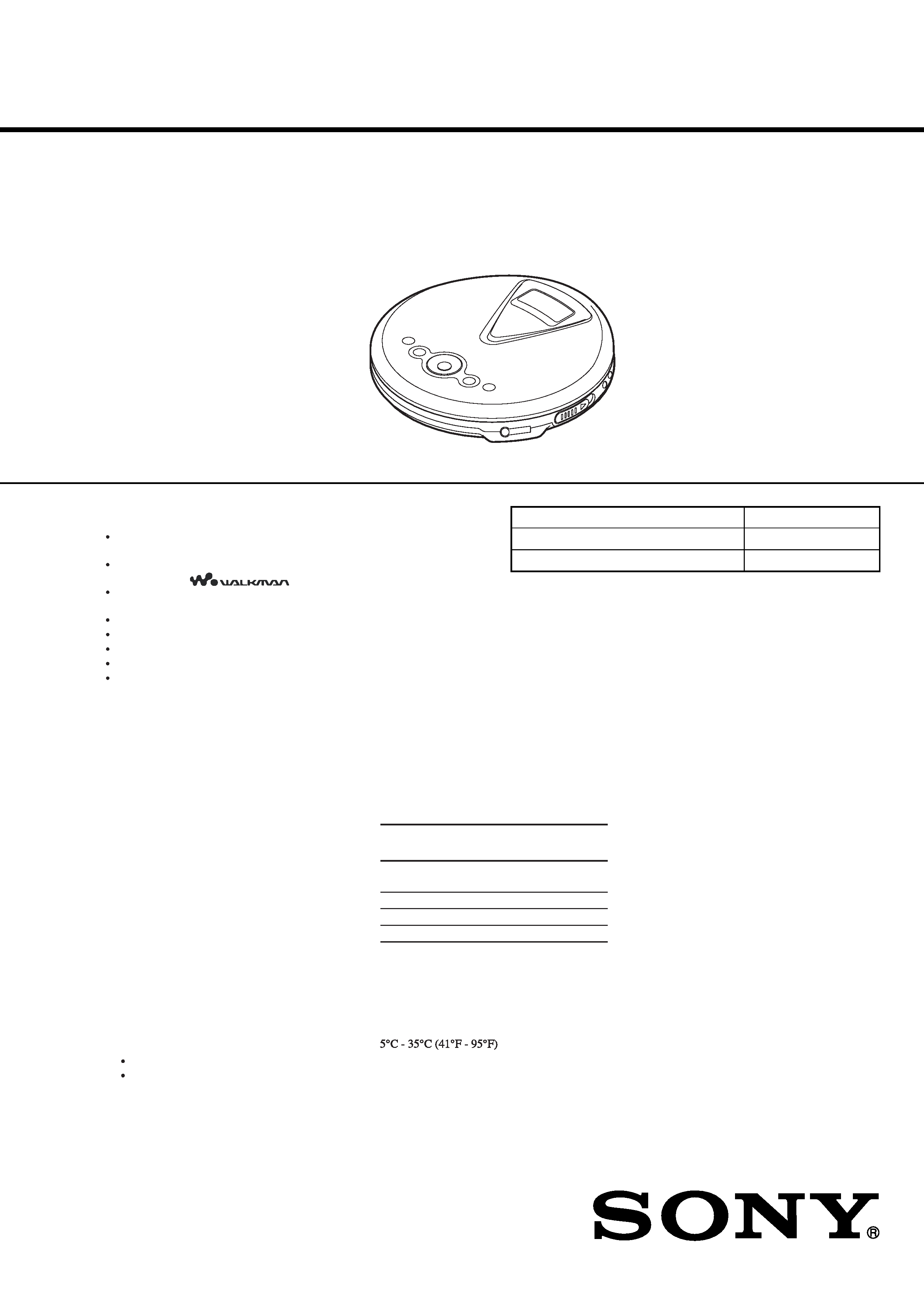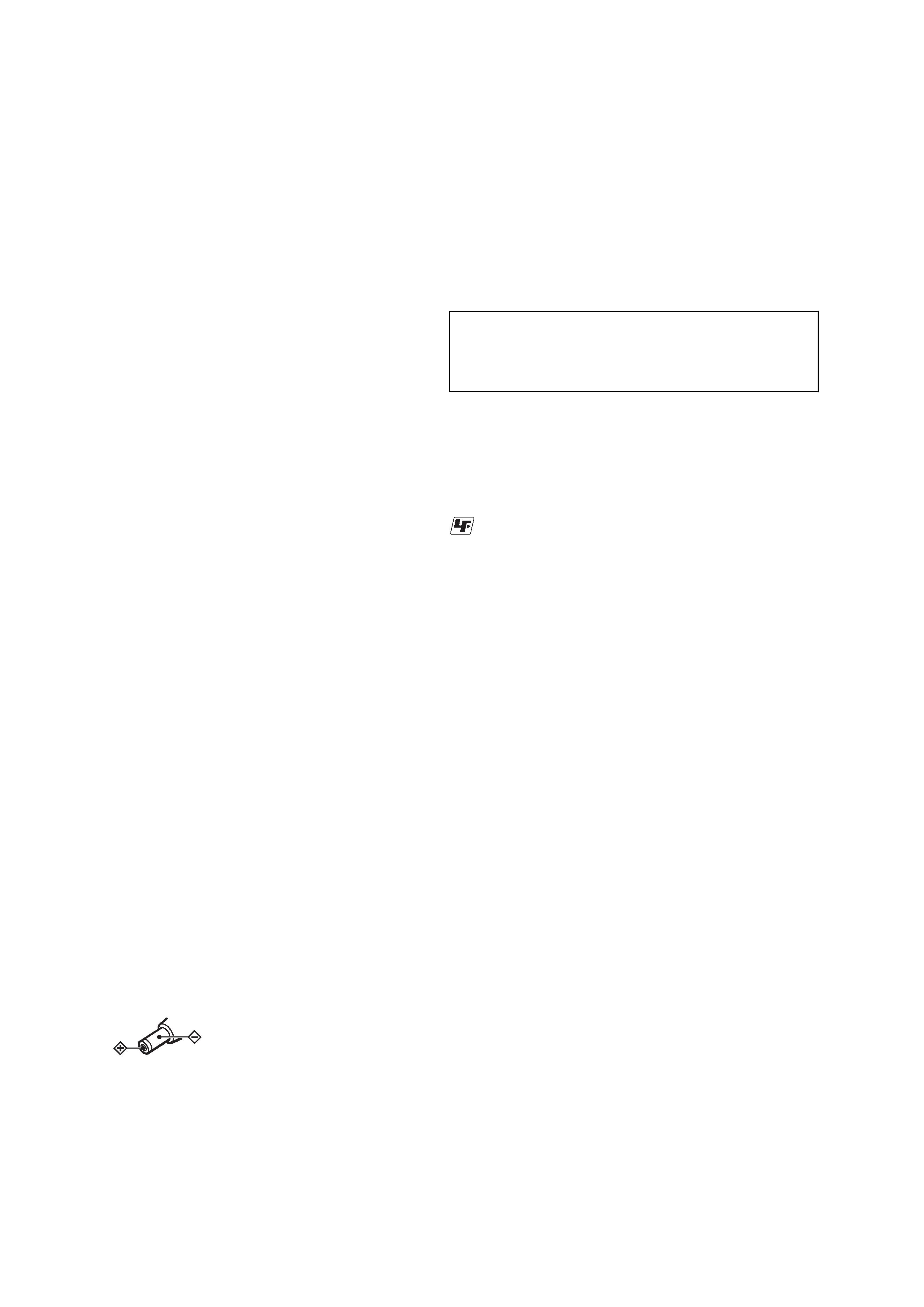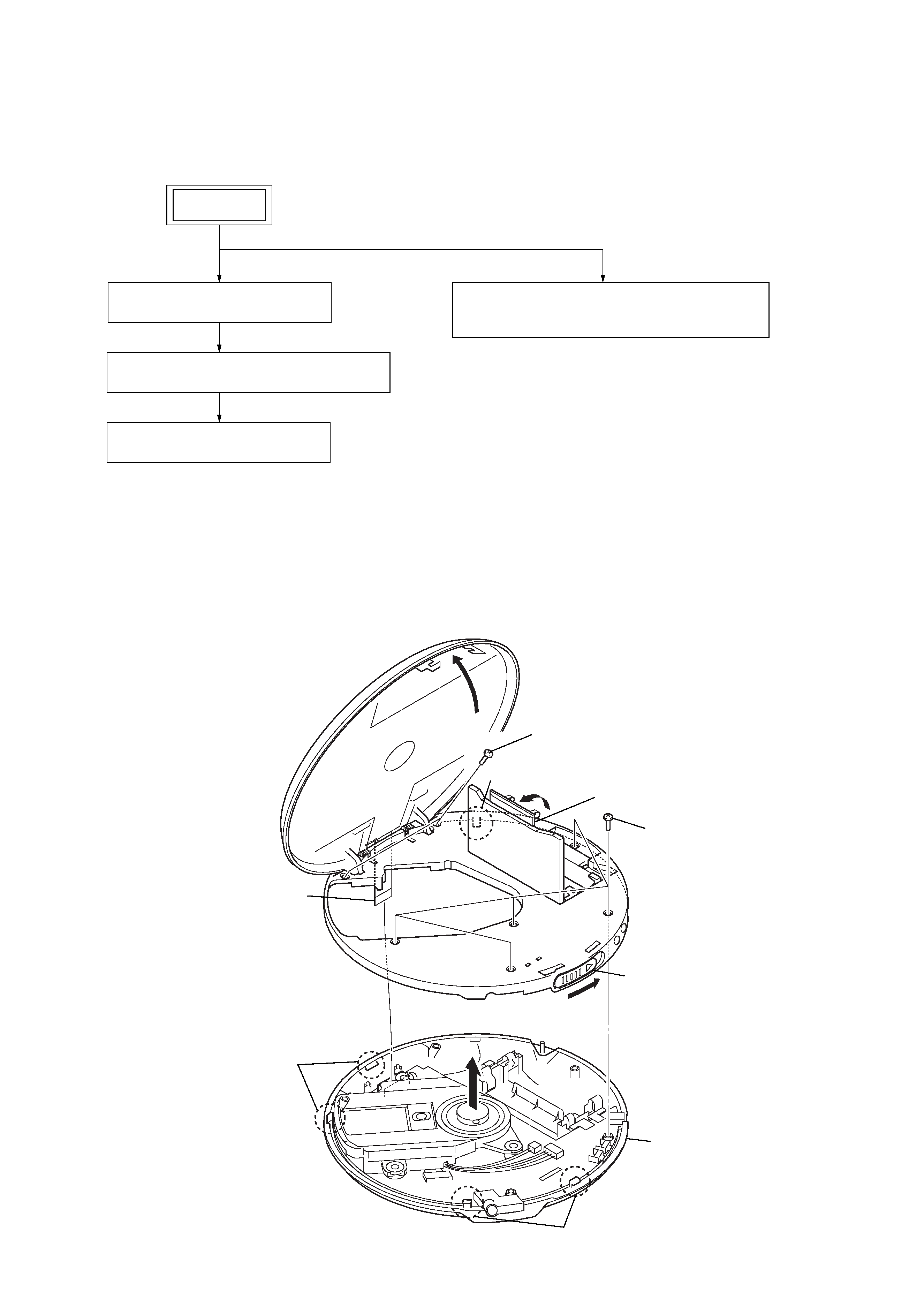
SERVICE MANUAL
Ver 1.1 2004.10
SPECIFICATIONS
PORTABLE CD PLAYER
D-NE309LIV2
US Model
9-877-626-02
Sony Corporation
2004J05-1
Personal Audio Company
© 2004.10
Published by Sony Engineering Corporation
System
Compact disc digital audio system
Laser diode properties
Material: GaAlAs
Wavelength:
= 770 - 800 nm
Emission duration: Continuous
Laser output: Less than 44.6
µW
(This output is the value measured at a distance
of 200 mm from the objective lens surface on
the optical pick-up block with 7 mm aperture.)
D-A conversion
1-bit quartz time-axis control
Frequency response
20 - 20 000 Hz
+1
-2 dB (measured by JEITA)
Output (at 4.5 V input level)
Headphones (stereo minijack)
Approx. 5 mW + Approx. 5 mW at 16
(Approx. 1.5 mW + Approx. 1.5 mW at 16
)*
*For the customers in Europe
Power requirements
Two LR6 (size AA) batteries: 1.5 V DC
× 2
AC power adaptor (DC IN 4.5 V jack):
120 V, 60 Hz
Battery life*1 (approx. hours)
When you use the CD player on a flat and stable
surface.
When SOUND mode is set to OFF .
Playing time varies depending on how the CD
player is used.
When using two Sony alkaline batteries
LR6 (SG) (produced in Japan)
G-PROTECTION
"G-PRO 1"
"G-PRO 2"
Audio CD
50
45
ATRAC CD*2
85
85
MP3 CD*3
65
65
*1 Measured value by the standard of JEITA (Japan
Electronics and Information Technology
Industries Association)
*2 Recorded at 48 kbps
*3 Recorded at 128 kbps
Operating temperature
Dimensions (w/h/d) (excluding
projecting parts and controls)
Approx. 135.8
× 30.7 × 135.8 mm
(5 3 8
× 1 1 4 × 5 3 8 in.)
Mass (excluding accessories)
Approx. 177 g (6.3 oz.)
Design and specifications are subject to change
without notice.
Headphones (1)
The AC power adaptor supplied is not intended to
be serviced. Should the AC power adaptor cease to
function in its intended manner, during the warranty
period, the adaptor should be returned to your
nearest Sony Service Center or Sony Authorized
Repair Center for replacement, or after warranty
period, it should be discarded.
CD-ROM*
*1 Do not play a CD-ROM on an audio CD player.
User s guide for SonicStage (1)
Active speaker system (1)*
*2 For operating procedures of the active speaker
system, refer to Operating Instructions for the
active speaker system supplied.
Desktop stand (1)
Supplied accessories
2
(SonicStage) (1)
1
OpenMG, ATRAC, ATRAC3, ATRAC3plus, SonicStage, SonicStage Simple
Burner and their logos are trademarks of Sony Corporation.
WALKMAN is a registered trademark of Sony Corporation to represent Headphone
is a trademark of Sony Corporation.
Microsoft, Windows, Windows NT are trademarks or registered trademarks of
Microsoft Corporation in the United States and/or other countries.
IBM and PC/AT are registered trademarks of International Business Machines Corporation.
Macintosh is a trademark of Apple Computer, Inc. in the United States and/or other countries.
Pentium is a trademark or a registered trademark of Intel Corporation.
Adobe and Acrobat Reader are trademarks of Adobe Systems Incorporated.
All other trademarks are trademarks of their respective owners. "
US and foreign patents licensed from Dolby Laboratories.
Stereo products.
and ¤ marks are omitted in this manual.
Model Name Using Similar Mechanism
D-NE300
CD Mechanism Type
CDM-3325ER
Optical Pick-up Name
DAX-25E

2
D-NE309LIV2
Notes on chip component replacement
·Never reuse a disconnected chip component.
· Notice that the minus side of a tantalum capacitor may be dam-
aged by heat.
Flexible Circuit Board Repairing
·Keep the temperature of the soldering iron around 270 °C dur-
ing repairing.
· Do not touch the soldering iron on the same conductor of the
circuit board (within 3 times).
· Be careful not to apply force on the conductor when soldering
or unsoldering.
TABLE OF CONTENTS
1.
SERVICING NOTES ............................................... 3
2.
GENERAL ................................................................... 4
3.
DISASSEMBLY
3-1. Disassembly Flow ...........................................................
5
3-2. Cabinet (Lower) Section .................................................
5
3-3. Optical Pick-up Assy (CDM-3325ER) ...........................
6
3-4. MAIN Board ...................................................................
6
3-5. Liquid Crystal Display Panel (LCD2001),
SWITCH Board ...............................................................
7
4.
TEST MODE .............................................................. 8
5.
ELECTRICAL CHECK .......................................... 9
6.
DIAGRAMS
6-1. Block Diagram ................................................................ 10
6-2. Note for Printed Wiring Boards and
Schematic Diagrams ....................................................... 11
6-3. Printed Wiring Board
MAIN Board (Component Side) .............................. 12
6-4. Printed Wiring Board
MAIN Board (Conductor Side) ................................ 13
6-5. Schematic Diagram MAIN Board (1/4) .................. 14
6-6. Schematic Diagram MAIN Board (2/4) .................. 15
6-7. Schematic Diagram MAIN Board (3/4) .................. 16
6-8. Schematic Diagram MAIN Board (4/4) .................. 17
6-9. Printed Wiring Board SWITCH Board ................... 18
6-10. Schematic Diagram SWITCH Board ...................... 19
7.
EXPLODED VIEWS
7-1. Cabinet (Inner) Section ................................................... 26
7-2. Cabinet (Upper) Section ................................................. 27
7-3. Cabinet (Lower) Section ................................................. 28
7-4. Optical Pick-up Section (CDM-3325ER) ....................... 29
8.
ELECTRICAL PARTS LIST ............................... 30
CAUTION
Use of controls or adjustments or performance of procedures
other than those specified herein may result in hazardous ra-
diation exposure.
SAFETY-RELATED COMPONENT WARNING!!
COMPONENTS IDENTIFIED BY MARK 0 OR DOTTED
LINE WITH MARK 0 ON THE SCHEMATIC DIAGRAMS
AND IN THE PARTS LIST ARE CRITICAL TO SAFE
OPERATION. REPLACE THESE COMPONENTS WITH
SONY PARTS WHOSE PART NUMBERS APPEAR AS
SHOWN IN THIS MANUAL OR IN SUPPLEMENTS PUB-
LISHED BY SONY.
UNLEADED SOLDER
Boards requiring use of unleaded solder are printed with the lead-
free mark (LF) indicating the solder contains no lead.
(Caution: Some printed circuit boards may not come printed with
the lead free mark due to their particular size)
: LEAD FREE MARK
Unleaded solder has the following characteristics.
· Unleaded solder melts at a temperature about 40 °C higher than
ordinary solder.
Ordinary soldering irons can be used but the iron tip has to be
applied to the solder joint for a slightly longer time.
Soldering irons using a temperature regulator should be set to
about 350 °C.
Caution: The printed pattern (copper foil) may peel away if the
heated tip is applied for too long, so be careful!
· Strong viscosity
Unleaded solder is more viscou-s (sticky, less prone to flow)
than ordinary solder so use caution not to let solder bridges oc-
cur such as on IC pins, etc.
· Usable with ordinary solder
It is best to use only unleaded solder but unleaded solder may
also be added to ordinary solder.
On AC power adaptor
¥ Use only the AC power adaptor supplied.
If your CD player is not supplied with the
one, use the AC-E45HG AC power
adaptor. Do not use any other AC power
adaptor. It may cause a malfunction.
Polarity of the plug
About CD-Rs/RWs
This CD player can play CD-Rs/RWs recorded in the ATRAC3plus/ATRAC3, MP3 or CDDA*
format, but playback capability may vary depending on the quality of the disc and the condition
of the recording device.
* CDDA is the abbreviation for Compact Disc Digital Audio. It is a recording standard used for the Audio
CDs.

3
D-NE309LIV2
Sys te m re qu ire m e n ts
The following hardware and software specificationsare required in order to use the SonicStage
Simple Burner software.
Computer
IBM PC /AT or Compatible
·CPU: Pentium II 300 MHz or higher (Pentium
III 600 MHz or higher is
recommended.)
·Hard disk drive space: System folder (on boot disc) 200 MB or more/
Temporary folder 200 MB or more (The a mount of free space
requi red differsaccording to the size of the audio filesthat you want to
handle. 1.5 GB of free space or more isrecommended.)
·RAM: 64 MB or more (128 MB or more isrecommended)
Others
· CD-R/RW drive (capable of digital playback by
WDM)
· Sound Board
Operating System Factory installed:
WindowsXP Home Edition /WindowsXP Professional/Windows
Millennium Edition/Wi ndows2000 Professiona l/Windows98 Second
Edition
Display
High Color (16 bit) or higher, 800
× 600 dotsor better
Others
· Internet access: for Web registration and CDDB services
·Adobe Acrobat Reader installed for viewing the PDF manual
Th is so ftwa re is not s upporte d by th e fo llo wing environments :
·NEC PC-98 seriesor compatible machines, Macintosh systems
· WindowsXP versionsother than Home Edition or Professional
· Windows2000 versionsother than Professional
· Windows98 versionsother than Second Edition
· WindowsNT
· Windows95
·Personally constructed PCsor operating systems
·An environment that isan upgrade of the original manufacturer-installed operating system
·Multi-boot environment
·Multi-monitor environment
No te s
·We do not ensure trouble-free operation on all computersthat satisfy the system requirements.
·We do not ensure trouble-free operation of the system suspend, sleep, or hibernation function on all
computers.
3. Push the N X button.
4. Observing the objective lens, check that the laser diode emits
light.
When the laser diode does not emit light, automatic power
control circuit or optical pickup is faulty.
In this operation, the objective lens will move up and down 4
times along with inward motion for the focus search.
SECTION 1
SERVICING NOTES
The laser diode in the optical pick-up block may suffer electro-
static breakdown because of the potential difference generated by
the charged electrostatic load, etc. on clothing and the human body.
During repair, pay attention to electrostatic breakdown and also
use the procedure in the printed matter which is included in the
repair parts.
The flexible board is easily damaged and should be handled with
care.
NOTES ON LASER DIODE EMISSION CHECK
The laser beam on this model is concentrated so as to be focused
on the disc reflective surface by the objective lens in the optical
pick-up block. Therefore, when checking the laser diode emis-
sion, observe from more than 30 cm away from the objective lens.
BEFORE REPLACING THE OPTICAL PICK-UP BLOCK
Please be sure to check thoroughly the parameters as par the "Op-
tical Pick-Up Block Checking Procedures" (Part No.: 9-960-027-
11) issued separately before replacing the optical pick-up block.
Note and specifications required to check are given below.
· FOK output: IC601 yg pin
When checking FOK, remove the lead wire to disc motor.
· RF signal P-to-P value: 0.45 to 0.65 Vp-p
LASER DIODE AND FOCUS SEARCH OPERATION
CHECK
During normal operation of the equipment, emission of the laser
diode is prohibited unless the upper lid is closed while turning ON
the S820. (push switch type)
The following checking method for the laser diode is operable.
· Method:
Emission of the laser diode is visually checked.
1. Open the upper lid.
2. With a disc not set, turn on the S820 with a screwdriver having
a thin tip as shown in Fig.1.
NOTES ON HANDLING THE OPTICAL PICK-UP
BLOCK OR BASE UNIT
Fig. 1 Method to push the S804
S820
detection lever
detection lever
MAIN board
· In performing the repair with the power supplied to the set, re-
moving the MAIN board causes the set to be disabled.
In such a case, make a solder bridge to short SL825 (OPEN/
CLOSE DETECT) on the MAIN board in advance.
MAIN Board (Component Side)
SL825
(OPEN)

4
D-NE309LIV2
SECTION 2
GENERAL
This section is extracted from
instruction manual.
Locating the controls
CD player
1 Operation button
u*1/ENTER: play/pause/
enter
.: AMS*2/rewind
>: AMS/fast forward
V/v: Use to select a
group, a file, play mode,
etc.
2
x (stop) button
3
( group) button
4
( group) + button
5 DISPLAY/MENU button
Use to enter the menu. Also use to enter
the selection, instead of u/ENTER.
6 i (headphones) jack
7 Display
8 DC IN 4.5 V (external power input) jack
9 VOL (volume) +*1/ buttons
q; OPEN switch
Slide the switch to open the CD player
lid.
qa HOLD switch (rear)
Slide the switch in the direction of the
arrow to disable the buttons on the CD
player.
*1 The button has a tactile dot.
*2 Automatic Music Sensor

D-NE309LIV2
5
SECTION 3
DISASSEMBLY
Note: Follow the disassembly procedure in the numerical order given.
3-2.
CABINET (LOWER) SECTION
· This set can be disassembled in the order shown below.
3-1.
DISASSEMBLY FLOW
4
five screws
5
claw
5
two claws
2
two screws
7
flexible flat (20core) cable
(CN801)
1
Open the cabinet (upper) section.
8
cabinet (lower) section
3
Open the battery case lid.
5
two claws
6
3-2. CABINET (LOWER) SECTION
(Page 5)
3-3. OPTICAL PICK-UP ASSY (CDM-3325ER)
(Page 6)
3-5. LIQUID CRYSTAL DISPLAY PANEL (LCD2001),
SWITCH BOARD
(Page 7)
SET
3-4. MAIN BOARD
(Page 6)
